Recently I came across on a surprisingly good deal on a Taurus Tracker .44mag snubnose. This one:

Taurus isn’t my first choice of firearm brands, but I’ve owned them and generally liked them, and the price on this one was a little too good to pass up. So I got it, figuring that it would be an interesting addition to my collection, occasionally using it as a carry gun.
After shooting it with a variety of .44special and .44mag loads that I had on hand, I decided that what I wanted to use as a carry ammo was something we’d tested: Corbon’s 165gr JHP. The lighter weight bullet would mean a lower felt recoil. And I knew how it would perform out of a short barrel, and estimated that I would get about 1150fps and just under 500ft/lbs of muzzle energy from the round. I checked locally, and the ammo wasn’t available, so I ordered in five boxes from a source online.
When it arrived, I did the logical thing and inserted five rounds into the Taurus, then closed the cylinder.
Er, make that I *tried* to close the cylinder. Because it wouldn’t. Huh?
I examined the gun. I had not noticed that the cartridges hadn’t gone completely into the chambers. The rims of the cartridges were all about 1/16th inch out. Oops. That was a mistake on my part — I should have been paying closer attention when handling the new untested ammo, rather than just assuming that it would load properly. This is what it looked like after I removed one cartridge for contrast:

Even lightly tapping the cartridges wouldn’t get them to load properly (where the rim is down on the rear cylinder face). I removed the rest of the cartridges, examined the gun to make sure everything was otherwise functioning properly. It seemed to be. I looked over the cartridges, and they seemed to be fine, as well. So I got a couple of different .44 loads — a mix of .44sp and .44mag — and put them into the cylinder. They all loaded just fine, the cylinder closed, and there were no problems. Here are a Hornady and a Winchester .44mag round in the cylinder, with one of the Corbon; note the difference:

Hmm.
Next, I got my Colt Anaconda .44 out of the safe. I tried the same ammo in it, and this is what I found:

Exact same problem. So, presumably, it was the Corbon ammo. I removed the rounds from the gun.
And grabbed my digital calipers. I started checking all the dimensions on the Corbon ammo. In fact, I went through and checked several sample cartridges from all five boxes. As far as I could tell, everything was in spec. The cases were the exact correct length. And width, both at the mouth of the case, along the body, and just above the rim. The bullets were the correct diameter. And the over length of the cartridges was well within the normal range of .44magnum rounds.
WTH?
I set the conundrum aside, so my subconscious could chew it over for a few hours. The likely explanation hit me while taking a shower the next morning. Here, look at the images of the three different rounds mentioned above, and see if you can spot it:

Here’s a hint: the Corbon cartridge is in the center.
Got it?
Yeah, if you look very carefully, you’ll see that the SHAPE of the Corbon bullet is different than the others. Note how it almost swells a bit, going up from the mouth of the case, to about an eighth of an inch, before narrowing down. Whereas the Winchester (on the left) and the Hornady (on the right) both have a smooth ogive right from the mouth of the case until coming to a flat nose (actually, the Hornady, like the Corbon, is a hollow point, but you can’t see that from this image).
So why did this cause the problem?
The explanation requires a bit of detailed knowledge about how a revolver works. If you already know all this, my apologies. For those who may not …
Each chamber in a revolver has to be big enough to accommodate the case of the cartridge. But the bullet is slightly smaller than that, so that it fits inside the cartridge case.
Now, when a chamber on a revolver rotates into position aligned with the barrel, there’s always a chance that it might not be perfectly aligned. Just a few thousandths of an inch misalignment can lead to all kinds of bad things happening, from parts of the bullet being shaved off and spit out the sides of the ‘cylinder gap‘ to the gun going KABOOM in your hand. So revolver manufacturers have come up with two nifty ways to deal with this:
- Narrowing the chamber in front of the cartridge case slightly by tapering it.
- Having a ‘forcing cone‘ before the barrel that is just a little bit bigger than the bullet, to funnel it into the barrel.
So, the problem with the Corbon ammo was that shape of the bullet in the pic above. Note how it doesn’t smoothly curve in like the other two bullets. Rather, that slight swelling is probably hitting the taper inside the chambers, stopping the cartridge from seating properly.
And before you say that this is a problem with the Taurus being poorly made, note that I ran into the exact same problem with my Anaconda — widely considered a very good quality gun.
Now, the folks at Corbon are smart. I’m sure their engineers actually tested this ammo in some typical .44magnum revolvers. But all it would take is for slight differences (think a couple thousandths of an inch) in the rate or position of that chamber tapering from manufacturer to manufacturer to cause this problem. Chances are, they just didn’t test it in a Taurus .44 of this model, or a Colt Anaconda. It is also possible that this batch of bullets (all five boxes I got are from the same lot — I checked) is just slightly out of spec, but no one has yet noticed it in their guns, because the tolerances in other manufacturers are a little bit different.
Either way, I’m fairly sure that I could just take some sandpaper or a fine file to that slight swelling on the bullets, and they’d fit right into my gun. But first I’m going to wait and see whether I hear back from Corbon about this issue (yeah, I sent them an explanatory email a couple days ago).
Oh, one last thing: in the process of going through all of this, I noticed that the cylinder length (from the front face to the rear face of the cylinder) on the Taurus was 1.625″, or 1 5/8″, whereas the cylinder length on my Anaconda is 1.75″, or 1 3/4″ — an eighth of an inch difference. As I recall, 1.75″ is standard for .44magnum revolvers. Interesting that the Taurus is slightly shorter, and that may indeed have had something to do with the shape of the chambers on the gun.
Edited, 2/27: Just a quick note. I’ve had some friends check other brands of .44mag revolvers. Seems that Smith & Wesson makes theirs with a cylinder length of 1.6875″ (1 11/16th”), and Ruger 1.75″ (1 3/4″). So there’s more variation than I thought.
Jim Downey
February 26, 2020
Posted by James Downey |
.44 Magnum, .44 Special, Anecdotes, Data, Discussion., Revolver | .44, ammo, ammunition, ballistics, BBTI, cartridges, Colt, Colt Anaconda, concealed carry, Cor-Bon, Corbon, data, Discussion., firearms, Hornady, jim downey, reviews, Taurus, Winchester |
1 Comment
Anyone who has considered a revolver as a self-defense option has confronted the question of whether, and how, to carry spare ammunition for it. Loose cartridges are just a pain to deal with, and take forever to reload. Speedloaders are great, but more than a little bulky. Commercial ‘speed strips’ are less bulky, are commonly available at a reasonable price, and are a big improvement over fumbling with loose rounds, but can still be awkward for reloading quickly. That’s because while they hold six cartridges, they’re difficult to position such that you can load an empty cylinder quickly — the close-packed cartridges actually get in the way. One common trick for using a speed strip is to only put two pairs of cartridges in it, with a gap between the two sets and the last position empty — that way, you can always quickly load two sets of two adjacent chambers in the cylinder of your revolver. This technique is perhaps best known due to defensive revolver guru Grant Cunningham.
Well, after recently taking a class with Grant, and learning this technique, I set out to make a more functional speed strip which would completely and quickly reload any revolver. One that almost anyone can make on their own, with minimal tools and expense, and customized to their revolver, whatever cartridge it shoots and whatever the capacity of the cylinder. I jokingly call it the Cunningham Perfect & Adaptable Speed Strip for Any Revolver regardless of Caliber or Capacity. More seriously, I’ll refer to it as the Cunningham Speed Strip, (CSS for short.)
Here some pics of what it can look like:

Bianci Speed Strip and custom homemade CSS (for a J-frame).
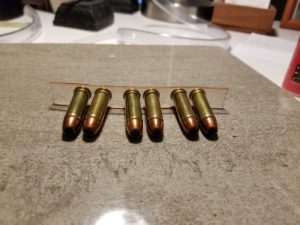
6 rounds of .38sp.

5 rounds of .38sp and 6 rounds of .44mag.
And this is how you make it.
YOU’LL NEED:
Tools
- A pair of common pliers
- A hammer of almost any type
- A pair of scissors or utility knife
You’ll also need
- A Heat Source (just about anything from a hair dryer to a blowtorch will do — you’ll see)
- An empty cartridge case for your revolver
- A pen or pencil
- A sheet of paper (really, just a scrap)
- A scrap piece of heavy cardboard or wood
- Suitable piece of inexpensive common vinyl (more on this to come)
PROCEDURE:
Select your vinyl. A wide variety of commonly available types of vinyl will work. If you look at the examples above you’ll see a piece from a 1/2″ ID vinyl tube, a piece of vinyl floor runner, and a piece of vinyl sheet used to cover food for microwaving. In other words, a wide variety of vinyl materials are likely to work.
So experiment a little. What you want is to find a vinyl which is flexible (not rigid/brittle) and sufficiently thick to hold cartridges in position, but will easily pull away when you have the cartridges in the chambers of the cylinder. The vinyl tubing is the one I like the most, and is 1/16″ thick. It has a slight tackiness to the surface I like because it makes it easier to use. The vinyl sheet is about one-third that thick, and the vinyl floor runner is somewhere between the two (though a little too flexible for my tastes).
Now, realize that it’s likely that any of these materials will tear after repeated use. These aren’t meant to last forever … but each of my prototypes have held up to at least a dozen uses so far. The idea is that they’re cheap and easy to make and replace.
Cut the vinyl to rough size. You want a working piece that you can trim later. Here’s what the tubing looks like when cutting:
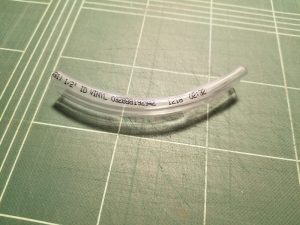
About a 6″ piece of tubing.

Slit along the sides.
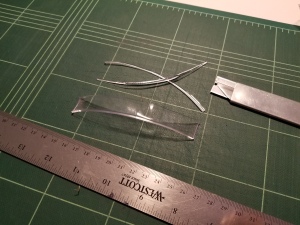
Flat section cut out.
Make a paper template. It’s difficult to mark most kinds of vinyl. So the easy thing to do is to make a paper template of what you want. For a J-frame, you want two sets of paired cartridges and one solo, with gaps in between the sets (as shown). For other guns, you may want a different arrangement. But in each case you want to use your empty cartridge case to draw the position of the circles on the paper. Like so:

Paper template.
Also note that I have a couple of marks showing the approximate ends of the strip. You want a bit of a tab on either end, to make it easy to grab and use the strip. But the final amount (and whether square or rounded off) is entirely up to your preference.
Position the template and vinyl for punching. Here I recommend that you use either a piece of dense cardboard or a scrap piece of wood. You can tape down the template if you want. But position the template, then lay the strip of vinyl on top of it in alignment with the template.
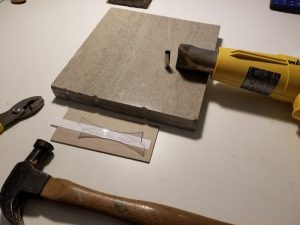
Position the template.
Heat up the case and/or strip. Again, the source of the heat really won’t matter. It can be a heat gun. Or a warm brick. Or a hair dryer. Whatever you have handy. Now, this may not be necessary. With some vinyls, you don’t need to really heat them up. But I have found that it makes things easier if you do, as the vinyl becomes softer and more pliable. And you can see in the image above that I have a .38sp case positioned in front of a heat gun, to make it even easier.
Position the case and strike with a hammer. If you have heated up the case, or if you’re worried about smacking your fingers with the hammer, the easy thing to do is to pick up the case with a common pair of pliers and then hold it in position. Put the mouth of the case over the vinyl/template in the correct position, then hit the case with the hammer.
How hard to hit, or how many times, will depend. But ideally, you want to have the case punch through the vinyl in a clean and complete way, so you have a small disk of removed vinyl left. This is the advantage of using the case instead of trying to cut the vinyl with a knife or drill bit: you wind up with a good clean cut the *exact* size of the cartridge.
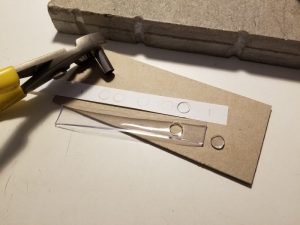
Clean through!
Repeat as many times as necessary. Until you have all the holes punched out.
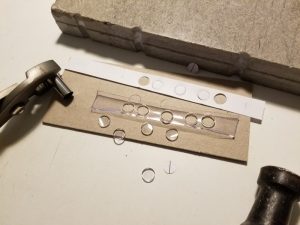
J-frame layout.
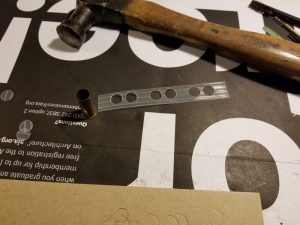
Anaconda layout.
Then trim the strip as desired. Once done, insert loaded cartridges and it’s ready to use.

5 rounds of .38sp and 6 rounds of .44mag.
That’s it!
I thought about patenting this idea, or seeing if I could sell it to some manufacturer. But it seemed like a good thing to just share as an ‘open source’ idea with the firearms/self-defense community so it could be used widely. If you found this instructional post useful in making your own customized speed strips, and would like to contribute a couple of bucks, just send a PayPal donation here: jimd@ballisticsbytheinch.com Proceeds will be shared with Grant Cunningham, who inspired this design.
Jim Downey
December 29, 2019
Posted by James Downey |
.22, .22WMR, .32 H&R, .327 Federal Magnum, .357 Magnum, .38 Special, .41 Magnum, .44 Magnum, .44 Special, Revolver | .22 lr, .22Magnum, .22WMR, .327 Magnum, .357Magnum, .38 Special, .41 Magnum, .44, ammo, ammunition, cartridges, concealed carry, firearms, guns, jim downey, Revolver, speed strips, technology |
8 Comments
Prompted by my friends over at the Liberal Gun Club, this is another in an occasional series of revisiting some of my old articles which had been published elsewhere over the years, perhaps lightly edited or updated with my current thoughts on the topic discussed. This is an article I wrote for Guns.com, and it originally ran 3/25/2012. Images used are from that original article. Some additional observations at the end.
~~~~~~~~~~~~~~~~~~~~~~~~~~~~~~~~~~~~~~~~~~~~~~~~
Colt was very late to the modern, double-action .44 Magnum game and then really only stuck around for a little while. Only after both Smith & Wesson and Ruger had become well established in that market did Colt even enter the game with its single offering—the Colt Anaconda revolver.
The Colt Anaconda
The Anaconda was only manufactured as a production gun from 1990 through 1999 and then as a limited Colt Custom Shop offering for a few years afterward, which is a shame because the Anaconda was actually a hell of a revolver.

It wasn’t quite up to the standards of the Colt Python, but in my opinion it’s equal to any other .44 magnum handgun on the market. I like the gun and have owned one with a six-inch barrel, which I bought used, for a number of years now.
The design of the Anaconda was based on the look of the Python. The new AA frame was much larger, scaled up to handle the much more powerful cartridge. The barrel look was the same as the classic Python, with a vent rib on top and a full lug underneath. The internal components were different from the Python, however, and were based on the King Cobra/Trooper models.
The Anaconda was only offered in stainless steel (usually a brushed finish, though they did offer some in a high polish finish). It had target-style sights, with a high-visibility red insert in the front and fully adjustable notch rear that had a slight white outline.
And typically the Anaconda came with rubber target grips bearing a silver Colt medallion, though ones with walnut grips featuring a gold Colt medallion are not uncommon (such as mine).
Initially offered only with a six-inch barrel, later models with a four-, five- (very rare), and eight-inch barrel were also available. The .44 Magnum/Special version is the most common, but there are plenty of Anacondas chambered for the .45 Colt cartridge as well.
Differences from the Colt Python
Unlike the Python, the internal mechanisms of the Anaconda did not get a lot of custom fitting before shipping. As a result, while the trigger is very good, it is not on a par with the Python. However, the whole gun is very robust and I’ve never heard of someone having problems with the cylinder getting slightly out-of-time (where the chamber alignment was no longer perfect), as is a weakness of the Python. The Anaconda locks up tight—“like a bank vault” is the common way it is described.

The Anaconda is a heavy gun, about the same weight as either the Ruger or S&W double-action .44s. The weight helps to moderate recoil, which can be very substantial with “full house” magnum loads. Personally, I like the walnut grips, but I have shot Anacondas with the original rubber grips and they are nice, as well.
Shooting
When Colt first introduced the guns, the Anaconda had embarrassing accuracy problems, so very quickly they stopped shipping the guns and retooled them. Subsequently the Anaconda is now considered very accurate.
Using the standard sights, I can easily hit a six-inch group at 50 yards, standing. I’ve never shot one with a telescopic sight (that I can recall), but they are purportedly perfectly accurate for a competent shooter out to at least 100 yards.
While I love and cherish my Python, I actually like shooting the Anaconda more. No, the trigger isn’t as buttery smooth as the Python, but I also don’t have a nagging worry about causing wear on the Anaconda. It is very strongly built, and has taken a real pounding of my very powerful .44 Magnum handloads over the years, without the slightest indication of any wear problems at all.
In single action, the trigger is extremely crisp and fairly light. In double action, it is a long, steady pull, smooth until it stages just a bit before the break. This is typical of the other Anacondas I have shot, as well.
Conclusion
Needless to say, given the size and weight of the Anaconda, this is not your ideal concealed-carry gun. But it would make one hell of a companion on your hip for any hunting or deep-woods expedition. Personally, I wouldn’t choose a handgun to go after grizzlies, but I also wouldn’t feel too under-gunned with an Anaconda (and the right loads), either.
Anacondas hold their value to this day, though at $1300 to $2000 they’re not priced at as much of a premium as the Python. Given how well the gun is made, if you find one at a price you like, I think you can buy it with confidence that it will last for many years (provided it hasn’t been abused in some way).
~~~~~~~~~~~~~~~~~~~~~~~~~~~~~~~~~~~~~~~~~~~~~~~~
There’s not much that I would add to that, except that I still have my Anaconda, still love to shoot it, and still thank my lucky stars that I got it before the prices for the things went nuts.
I do want to note that about a year after I wrote the above I was doing some informal testing of some .44 magnum ammo on the market, and discovered the Buffalo Bore 340gr +P+ loads. Full info here and here, but let me just say Oh Baby! 1300 fps out of my Anaconda means almost 1300 foot-pounds of energy. Yeah, I’d take that into bear country, no question.
Jim Downey
November 2, 2017
Posted by James Downey |
.44 Magnum, .44 Special, Discussion. | .44, ammo, ammunition, ballistics, BBTI, Buffalo Bore, cartridges, Colt Anaconda, Colt Python, data, Discussion., firearms, guns, Guns.com, jim downey, Liberal Gun Club, reviews |
Leave a comment
All along, we’ve said that if someone wanted to take the time, trouble, and expense to do some additional research along the lines of our protocols, that we’d be happy to include their data on our site. This is particularly true if it helped expand the selection of “real world guns” associated with the data for a given caliber/cartridge. Well, for the first time someone has expressed an interest in doing just that, prompting us to come up with an outline of what standards we feel are required for making sure it relates to our previous tests.
The biggest problem is that ammo manufacturers may, and do, change the performance of their products from time to time. This is why we have on occasion revisited certain cartridges, doing full formal chop tests in order to check how specific lines of ammo have changed. That gives us a benchmark to compare other ammo after a period of several years have passed, and shows how new tests relate to the old data.
But without going to such an extent, how can we be reasonably sure that new data collected by others using their own firearms is useful in comparison to our published data?
After some discussion, we feel that so long as any new testing includes three or more of the specific types of ammo (same manufacturer, same bullet weight & design) we had tested previously, then that will give enough of a benchmark for fair comparison. (Obviously, in instances where we didn’t test that many different types of ammo in a given cartridge, adjustments would need to be made). With that in mind, here are the protocols we would require in order to include new data on our site (with full credit to the persons conducting the tests, of course):
- Full description and images of the test platform (firearm) used in the tests. This must specify the make, model number, barrel length, and condition of the firearm. Ideally, it will also include the age of the firearm.
- That a good commercial chronograph be used. Brand isn’t critical — there seems to be sufficient consistency between different models that this isn’t a concern. However, the brand and model should be noted.
- Chronographs must be positioned approximately 15 feet in front of the muzzle of the firearm used to test the ammo. This is what we started with in our tests, and have maintained as our standard through all the tests.
- That five or six data points be collected for each type of ammo tested. This can be done the way we did it, shooting three shots through two different chronographs, or by shooting six shots through one chronograph.
- All data must be documented with images of the raw data sheets. Feel free to use the same template we used in our tests, or come up with your own.
- Images of each actual box of ammo used in the test must be provided, which show the brand, caliber/cartridge, and bullet weight. Also including manufacturer’s lot number would be preferred, but isn’t always possible.
- A note about weather conditions at the time of the test and approximate elevation of the test site above sea level should be included.
We hope that this will allow others to help contribute to our published data, while still maintaining confidence in the *value* of that data. Please, if you are interested in conducting your own tests, contact us in advance just so we can go over any questions.
Jim Downey
September 9, 2016
Posted by James Downey |
.22, .223, .22WMR, .25 ACP, .30 carbine, .32 ACP, .32 H&R, .327 Federal Magnum, .357 Magnum, .357 SIG, .38 Special, .380 ACP, .40 S&W, .41 Magnum, .44 Magnum, .44 Special, .45 ACP, .45 Colt, .45 Super, .450 SMC, .460 Rowland, 10mm, 9mm Luger (9x19), 9mm Mak, 9mm Ultra, Anecdotes, Data, Discussion., General Procedures | .22 lr, .223, .22Magnum, .22WMR, .25 ACP, .32 ACP, .32 H&R, .327 Magnum, .357 SIG, .357Magnum, .38 Special, .380 ACP, .40 S&W, .41 Magnum, .44, .45 ACP, .45 Colt, .45 Super, .450 SMC, .460 Rowland, 10mm, 9mm, 9mm Luger, 9mm Makarov, 9mm Police, 9mm Ultra, ammo, ammunition, ballistics, BBTI, cartridges, data, Discussion., firearms, guns, jim downey |
Leave a comment
Well, well, well, BBTI made it to six years of shooting fun and research!
Yup, six years ago today we posted the first iteration of Ballistics By The Inch, and included data for 13 different handgun cartridges. Since then we’ve continued to expand on that original research, including some extensive testing on how much of an effect the cylinder gap on revolvers has, what performance differences you can expect from polygonal over traditional land & groove rifling, and added another 9 cartridges, as well as going back and including a very large selection of real world guns in all the different cartridges. This blog has had 100,000+ visitors and the BBTI site itself has had something like 25 – 30 million visits (the number is vague because of changes in hosting and record-keeping over time).
We’ve had an impact. I’ve seen incoming links from all around the world, in languages I didn’t even recognize. There’s probably not a single firearms discussion group/blog/site out there which hasn’t mentioned us at some point, and our data is regularly cited in discussions about the trade-offs you make in selecting one cartridge or barrel length over another. I’ve answered countless emails asking about specific points in our data, and have been warmly thanked in return for the work we’ve done. And on more than a few occasions people have pointed out corrections which need to be made, or offered suggestions on how we could improve the site, sometimes providing the results from their own crunching of our data.
When we started, it was fairly unusual to see much solid information on ammo boxes about how the ammunition performed in actual testing. Now that information is common, and expected. Manufacturer websites regularly specify real performance data along with what kind of gun was used for that testing. And the data provided has gotten a lot more … reliable, let’s say. We’ve been contacted by both ammo and firearms manufacturers, who have asked if they can link to our data to support their claims of performance — the answer is always “yes” so long as they make it clear that our data is public and not an endorsement of their product. And we’ve never taken a dime from any of those companies, so we can keep our data unbiased.
And we’re not done. We have specific plans in the works to test at least one more new cartridge (and possibly revisit an old favorite) in 2015. I try to regularly post to the blog additional informal research, as well as sharing some fun shooting and firearms trials/reviews. There’s already been one firearms-related patent issued to a member of the BBTI team, and we’ll likely see several more to come. Because we’re curious guys, and want to share our discoveries and ideas with the world.
So, onward and upward, as the saying goes. Thanks to all who have cited us, written about us, told their friends about us. Thanks to all who have taken the time to write with questions and suggestions. And thanks to all who have donated to help offset the ongoing costs of hosting and testing — it makes a difference, and is appreciated.
Jim Downey
November 28, 2014
Posted by James Downey |
.22, .223, .22WMR, .25 ACP, .30 carbine, .32 ACP, .32 H&R, .327 Federal Magnum, .357 Magnum, .357 SIG, .38 Special, .380 ACP, .40 S&W, .41 Magnum, .44 Magnum, .44 Special, .45 ACP, .45 Colt, .460 Rowland, 10mm, 6.5 Swedish, 9mm Luger (9x19), 9mm Mak, 9mm Ultra, Anecdotes, Data, Discussion., General Procedures, Links, Shotgun ballistics | .22 lr, .22Magnum, .22WMR, .38 Special, .380 ACP, .44, .45 ACP, .460 Rowland, 9mm, ammo, ammunition, ballistics, BBTI, cartridges, data, Discussion., firearms, guns, jim downey, reviews, rifling, world guns |
1 Comment
So, the beginning of July I posted an entry about some informal .44 data I had collected. As I said at the time:
I was prompted to do so because I had picked up some new Buffalo Bore ammunition that I wanted to try.
Specifically, this ammo: Buffalo Bore 340gr .44mag
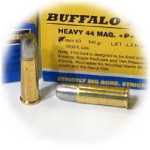
And I was VERY impressed with the performance of that ammunition, since it generated over 1653 fps/2063 ft-lbs out of my Winchester 94. However, there was a problem: it wouldn’t feed in my levergun. Oh, it shot and extracted just fine, but you couldn’t rack a new cartridge from the magazine into the chamber — they would invariably get stuck. Thus making the gun a single-shot, at least as far as that particular ammo was concerned.
So I started thinking about ways around this problem.
My first thought was that perhaps I could develop a similar cartridge using a .44special case. I knew the history of the development of the .44magnum, so i figured that it was probable that the .44special brass would withstand the pressures involved, and give me about 1/8th inch (the difference between the case length of the .44special and the .44magnum) to play with. I found a suitable bullet, and did a little research to see whether anyone had recently tried to develop such power out of a .44special case.
My research pointed to the possibility of developing full .44magnum power out of a .44special case (which was what was done historically, so no big surprise there). And over the course of the last month I worked up two different flights of test ammo experimenting with that idea.
What results did I get? Well, let’s just say that you can indeed get some very powerful rounds using .44special cases. Indeed, using 240 grain bullets (which are fairly standard for the .44) I had considerable success. The rest of the equation is left to the experienced reloader to determine for themselves.
With the 330 grain bullets, though, it was a different story. When approaching the upper end of the published data for .44magnum, I started to see indications of stress on the spent brass which made me … nervous. Enough so that I decided not to risk shooting the last couple of test rounds. Draw your own conclusions.
And the chronographed power results were only about half of what the Buffalo Bore ammunition I was trying to emulate demonstrated. Hmm.
Now, it is possible that with a different type of gunpowder, I might be able to come to a different result with my shorter .44special reloads. Maybe.
But we all know how hard it can be to find preferred types of gunpowder these days. So I decided to reconsider my strategy. After all, what I wanted was to have the power of the Buffalo Bore loads, but in a cartridge which would feed reliably in my levergun.
The result? I decided to try to change the shape of the bullet in the Buffalo Bore cartridge, so that the hard leading shoulder would be rounded off in such a way as to properly feed in my gun. After a bit of experimentation this afternoon, this is what I came up with:

Note the rounded cartridge on the left, next to an unaltered cartridge on the right. In the pan for my balance beam scale you can see the bulk of the lead removed from the bullet in the cartridge on the left. Now, that’s not all of the lead I removed — but it is probably the vast majority of it, since I did the removal over a sheet of paper using a rasp, and then weighed the shavings (which turned out to be 10.5 grains, btw).
That cartridge feeds fine in my levergun. No problems. So the trick will be to experiment with seeing how little lead I can remove while still getting reliable feeding, and getting good at doing so uniformly so as to not really screw up how the bullet behaves aerodynamically. That should be a manageable matter. (Edited to add: see my solution here.)
But I also think I’ll drop Buffalo Bore a note, and see if I can get them to tweak the design of the bullet just a tad to make it more friendly for us levergun owners. Thanks to BBTI, I should have enough cred that perhaps they’ll take note.
We’ll see.
Jim Downey
August 1, 2013
Posted by James Downey |
.44 Magnum, .44 Special | .44, Buffalo Bore, cartridges |
10 Comments
When we did the .44 Special and .44 Magnum tests, I didn’t yet own my 6″ Colt Anaconda. And since my Winchester Model 94AE has a 24″ barrel, we decided to not include it in the tests (which only go up to 18″).
But this afternoon I decided to take my solo chronograph and go out and do a bit of informal testing. I was prompted to do so because I had picked up some new Buffalo Bore ammunition that I wanted to try. But since I was going out anyway, I decided to grab whatever factory ammo I had and just do a little informal testing. What follows are the results … using just one chrono, and usually just shooting just two or three rounds and averaging them. Below the velocity is calculated Muzzle Energy.
Ammo Anaconda Winchester 94
Ultramax 200gr .44sp 739 fps/242 ft-lbs 965 fps/414 ft-lbs
Remington 246gr .44sp 717 fps/281 ft-lbs 911 fps/453 ft-lbs
Federal Hydra-Shok 240gr .44mag 1277 fps/869 ft-lbs 1705 fps/1550 ft-lbs
Hornady 240gr .44mag 1376 fps/1009 ft-lbs 1859 fps/1842 ft-lbs
Remington 240gr .44mag 1340 fps/957 ft-lbs 1754 fps/1640 ft-lbs
Buffalo Bore 340gr .44mag 1310 fps/1296 ft-lbs 1653 fps/2063 ft-lbs
Of course, raw power isn’t everything. Actual terminal ballistics makes a big difference, depending on what you want: expansion, or deep penetration? Recoil is also more problematic (particularly out of a handgun) the more power there is. And the Buffalo Bore ammo isn’t suitable for all guns — some just aren’t built strong enough for that kind of power, and others will have problems loading. My Winchester 94 levergun would not cycle the Buffalo Bore, meaning that I could not rack a new round into the chamber after shooting one (though it shot them just fine and would extract them without a problem). One look will tell you why:

Hornady JHP and Buffalo Bore LFN
Some other pics to share:

Ammo selection.

Guns used.
And a graphic demonstration in the power difference between the performance of bullets shot out of the revolver and the rifle: using the same reload (a 245gr LRN with 8.5gr of Titegroup), shot from about 25 yards. The can hit with the Anaconda on the left, the rifle on the right.

Jim Downey
July 2, 2013
Posted by James Downey |
.44 Magnum, .44 Special, Anecdotes, Data, Discussion. |
6 Comments
The new Ballistics By The Inch site is now up and running! Bigger, Faster, And with More DATA! Take a look, spread the word, let us know if there are any glitches or problems.
Jim Downey
December 1, 2011
Posted by James Downey |
.22, .223, .25 ACP, .32 ACP, .32 H&R, .327 Federal Magnum, .357 Magnum, .357 SIG, .38 Special, .380 ACP, .40 S&W, .41 Magnum, .44 Magnum, .44 Special, .45 ACP, .45 Colt, .460 Rowland, 10mm, 9mm Luger (9x19), 9mm Mak, 9mm Ultra, Anecdotes, Data, Discussion., General Procedures, Links | ballistics, BBTI, data, Discussion., guns |
Leave a comment
Just spent a chunk of the afternoon and early evening doing something I had been meaning to do for at least a year: adding info about BBTI to various and sundry Wikipedia pages about ballistics and cartridges. I still need to create an actual ‘page’ about BBTI, but haven’t ever done that, so . . .
Anyway, now for all the cartridges/calibers we tested there are links on Wikipedia, plus any related entries that I could think of. But if you find yourself poking around there, and come across an entry which would appropriately link/mention BBTI, please edit it to do so (or drop me a note and I’ll take care of it.) This isn’t an effort to get more hits to the BBTI site (we’re rapidly approaching 2.5 million), but just to help more people get the information that they need.
Jim Downey
April 30, 2010
Posted by James Downey |
.25 ACP, .32 ACP, .32 H&R, .327 Federal Magnum, .357 Magnum, .357 SIG, .38 Special, .380 ACP, .40 S&W, .41 Magnum, .44 Magnum, .44 Special, .45 ACP, .45 Colt, 10mm, 9mm Luger (9x19), Data, Discussion., Links, Uncategorized |
2 Comments
Just under a month ago I wrote about launching the major upgrade to BBTI. Since then, we’ve had 217,390 hits to the site, bringing us to just shy of one million hits (986,999) as of midnight. Given how things have been going the last couple of days, I expect we’ll break a million today or tomorrow. [edited to add: we had over 21 thousand hits on 6/27, thereby crossing a million.]
And that’s kinda cool.
So, thanks to all who passed along word of our project. In particularly, our top ten referrers have been:
- www.darkroastedblend.com
- www.google.com
- www.defensivecarry.com
- www.thefirearmblog.com
- www.ar15.com
- www.thehighroad.org
- www.thefiringline.com
- ballisticsbytheinch.wordpress.com
- forums.somethingawful.com
- www.saysuncle.com
I find it interesting that the top referrer (by a long shot) isn’t even a firearms-related site. That we’ve risen high in Google searches comes as very little surprise, and I’m pleased that the BBTI blog itself has such a prominent spot, just after five of the best known gun forums/blogs. That’s kinda cool, too.
Anyway, thought I would pass this bit of good news along.
Jim Downey
(Cross posted to my personal blog.)
June 27, 2009
Posted by James Downey |
.25 ACP, .32 ACP, .32 H&R, .327 Federal Magnum, .357 Magnum, .357 SIG, .38 Special, .380 ACP, .40 S&W, .41 Magnum, .44 Magnum, .44 Special, .45 ACP, .45 Colt, 10mm, 9mm Luger (9x19), Data, Links |
1 Comment
Six months ago we launched Ballistics By The Inch. And since then we’ve had over 770,000 hits, one major magazine article, and coverage & discussion of the site in countless gun forums & blogs around the globe. When I have checked the stats for the site, I have never failed to be impressed with just how widely it has become known.
Well, tonight we posted a major upgrade to the whole site. This includes three additional caliber ‘chop tests’, but it also includes data collected from testing over 40 additional “real world” guns – including a baker’s dozen carbine-length guns. This data has been separated out into a new series of graphs for easy comparison. All together, there are now over 150 graphs showing ballistic performance – along with all the charts giving numerical averages for each 1″ increment in barrel length for 16 different calibers. And for the true data junkies, there are downloadable files (in two formats) for the entire sequence of initial tests, and another set for the second round of testing done in April 2009.
Like the initial project, this major upgrade and revision has been a huge job – and one only made possible by a lot of work from several individuals. Yes, there were the three of us testers from the original project. But there was also the addition of a fourth tester this time around who helped us gather & operate all those ‘real world’ guns, and I would like to welcome Keith to our team. But I would especially like to thank my good lady wife for all the html coding & design for our website – both the last time and with this major revision. Quite literally, none of this would have been available without her hard work.
There will probably be minor tweaks and additions to the site in the coming months and years. We still have some ideas of data which might be of interest to the gun community. But for now we hope that you will enjoy and make use of the data provided, and help to spread the word to others who may be interested.
Cheers!
Jim Downey
(Cross posted to my personal blog.)
May 28, 2009
Posted by James Downey |
.25 ACP, .32 ACP, .32 H&R, .327 Federal Magnum, .357 Magnum, .357 SIG, .38 Special, .380 ACP, .40 S&W, .41 Magnum, .44 Magnum, .44 Special, .45 ACP, .45 Colt, 10mm, 9mm Luger (9x19), Data |
3 Comments
When we did the original round of tests, we used one or two ‘real world’ pistols for each caliber as a reference point for people to compare to the ideal platform of the T/C Encore. We thought that this would be adequate. But it quickly became evident that a lot of people wanted more data points of how ‘real world’ guns would compare at different barrel lengths.
So one of the major goals of this most recent round of testing was to revisit those calibers we had tested last year using a lot more ‘real world’ guns. In preparation for the testing, we started asking around from friends and family, until we had over 40 additional guns to test, in different lengths and quality. Here is that list:
Para LDA Carry 9 – 9mm, 3” barrel
Korth semi-auto – 9mm, 5″ barrel
Beretta 92 FS – 9mm, 4.875” barrel
Kimber Target ll 1911 – 9mm, 5” barrel
Sig P210 Target Heavy Frame – 9mm, 6” barrel
DSA TP-9 – 9mm, 6″ barrel
Beretta Cx4 Storm – 9mm, 16″ barrel
Kel Tec Sub-2000 – 9mm, 16″ barrel
Special Weapons MP5 Clone – 9mm, 16″ barrel
Infinity – .357 Sig, 6″ barrel
Bond Texas Defender – .357 Mag, 3” barrel
Colt Detective Special – .38 Special, 2.125” barrel
Smith & Wesson 627-3 – .357 Mag, 5” wo brake / 5.625” with brake
Korth revolver – .357 Mag, 5.875” barrel
Winchester Model 94AE – .357 Mag, 16” barrel
Stoeger Buntline – .357 Mag, 18” barrel
Beretta 96 Elite ll Brigadier – .40 S&W, 4 1/2” barrel
Rocky Mountain Armoury Sphinx – .40 S&W, 4 1/2” barrel
Browning Hi-Power – .40 S&W, 4 5/8” barrel
Ruger PC4 Carbine – .40 S&W, 16″ barrel
Bond Arms “Texas Defender” Derringer – .44 Mag, 3″ barrel
Smith & Wesson 629-5 Mountain Packer (ported) – .44Mag, 3” barrel
Smith & Wesson 629-5 Performance Center – .44 Mag, 4 7/8” wo brake 5 5/8” with brake
Smith & Wesson Model 629 Classic – .44 Mag 6 1/2”
Smith & Wesson Model 629 – .44 Mag, 12” barrel
Henry Golden Boy – .44 Mag, 20” barrel
Smith & Wesson Model 325PD (Airlite) – .45 ACP Revolver, 2 1/2″ barrel
Bond Texas Defender – .45 ACP, 3” barrel
Para LDA PDA – .45 ACP, 3” barrel
Beretta Model 8045 Cougar – .45 ACP, 3.625” barrel
Ed Brown 1911 – .45 ACP, 6” barrel
Group IND UZI – .45 ACP, 16″ barrel
Kahr Thompson – .45 ACP, 16″ barrel
Vector Arms Kriss Super V – .45 ACP, 16″ barrel
La France M16 – .45 ACP, 16″ barrel
Bond Derringer – .45 Colt/.410, 3 1/2” barrel
Navy Arms Schofield – .45 Colt, 3 1/2” barrel
Cimarron (Uberti) Colt – .45 Colt, 5 1/2” barrel
Cimarron (Uberti) Colt – .45 Colt, 7 1/2” barrel
Beretta Stampede Buntline Carbine – .45 Colt, 18” barrel
1892 Winchester Lever Action Rifle (reproduction) – .45 Colt, 20″ octagonal barrel
Quite a list, eh?
Jim Downey
April 23, 2009
Posted by James Downey |
.357 Magnum, .357 SIG, .38 Special, .40 S&W, .44 Magnum, .44 Special, .45 ACP, .45 Colt, 9mm Luger (9x19), Anecdotes, Data, Links |
1 Comment
OK, this is going to be a bit of a catch-all entry, where I (and I hope Jim K and Steve) will post some little comments and observations about doing the project. A lot of this stuff you would probably find if you poke around deep enough in either the Emails or the flickr images, but it’s nice to get an individual story as well.
* * *
See the title on the site? The tag line: “Three guys, two chronographs, and 7,000 rounds of ammo . . . ” really oughtta be “Three guys, FOUR chronographs, and 7,000 rounds of ammo . . . ”
Yeah, we killed two chronographs. Put a bullet (a .45 colt, if memory serves) right through the forehead of the first one, which went through the one behind it. Happened during the first day of testing in the second flight of tests. I blogged about it that night; here’s an excerpt:
What happened was this: one of us (who shall for now remain nameless, until I can spend more time to write up the saga appropriately) was in the middle of shooting the second most powerful of the calibers we’re testing, and didn’t manage to control the gun completely when he fired the round. And it went right through both chronographs. Perfectly.
We use two chronographs, lined up one in front of the other, to be sure we’re getting good data. He hit the first one right dead center, a little high from the middle. Like a perfect shot in a movie, hitting the bad guy right between the eyes. The large bullet punched through the display, destroyed the electronics, and shattered the back of the chrono – then entered the front sensor of the second chrono, exiting out the bottom rear sensor as well.
It was spectacular. A perfect shot. I have pix I’ll be posting later.
Ah, good times, good times. We put an armour plate (a railway tie plate) in front of the next set of chronographs from then on. Good thing, too, that saved us probably another five or six sets of chronographs. Live and learn.
Jim Downey
December 1, 2008
Posted by James Downey |
.25 ACP, .44 Magnum, .44 Special, .45 Colt, Anecdotes |
2 Comments























